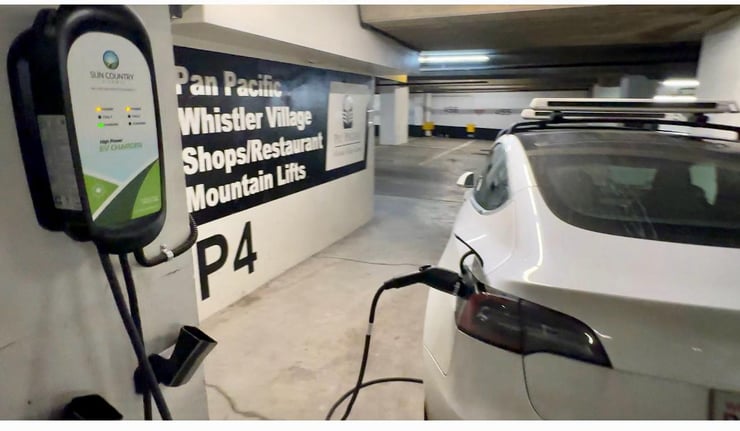
Smart vs. Dumb EV Chargers
Networked vs. Non-Networked EV Chargers
INDUSTRY


Differences between Smart and Dumb EV Chargers
You may hear people referring to EV Chargers as networked or non-networked. Simply put, networked chargers are connected to the internet and non-networked chargers are not. As you can imagine, chargers that are connected to the internet have many more capabilities than ones that are not.
In this guide you’ll find everything you need to know about networked vs. non-networked EV Chargers, including:
Capabilities and limitations of each
Different types of networks connections and how they work
Tips to succeed with your decision about the best type of chargers for your needs
Read on for a break down that you won’t find anywhere else.
What are Smart Chargers and Dumb Chargers?
These are just slang terms used in the industry to describe Networked and Non-Networked Chargers. Smart Chargers or “Networked Chargers” are connected to the internet. They are networked for data communication and are integrated into a larger computer system called a Network Management System. Dumb Chargers or “Non-Networked Chargers” have limited functionality and aren’t connected to the internet or a larger network. They’re out there on their own. I’ll go into more detail about the differences between the two below.
Various Charger Examples
What are Non-Networked EV Chargers?
Non-Networked Chargers as you may have guessed are EV chargers that have no network connection. Meaning they are not connected to the internet. The chargers still work fine but their capabilities are limited. Similar to when your cell phone is out of service or not connected to Wi-Fi. You can still use the phone to perform the basic functions like type notes or find contacts but you can’t access an entire network of information that would be available through the internet.
Limitations of a Non-Networked Charger
Applying this to a charger, a non-networked charger can provide basic charging services. Users can plug-in an electric vehicle and receive a charge but that’s about it. You aren’t able to monitor your status of charge remotely from your phone. You can’t check ahead of time to see if someone else is using the charger, or if the charger is even working.
Why would I use a Non-Networked Charger?
Non-networked chargers are usually found at home for personal use and are much cheaper to install than networked chargers. They’re also free because they cannot accept payment. Most electric vehicles are sold with a level 1 non-networked charger included with the car. These chargers are intended for home use and usually plug in to a standard 120v outlet (like your iPhone). They are very low voltage and have extremely long charging times. Sometimes up to 24-48 hours depending on the size of the car. Most EV drivers prefer to use public level 2 chargers for a much faster charge. These are rarely free and often require downloading an app to provide payment information. These are networked chargers and we’ll dive into the differences here next.
Various Charger Examples
What are Networked EV Chargers?
The more advanced version of the chargers previously discussed are Networked chargers. Simply put, these are connected to the internet. They will need to be connected to some form of software which allows you the manage the charger through the app. Most often these are connected to the internet through Wi-Fi or cellular connection wth a SIM card. Being connected to a network allows the charger to communicate with a larger network. This enables a wide array of capabilities which enhance the charging experience for both EV owners and operators of the chargers.
Capabilities of a Networked Charger
As we all know, the benefits of the internet are endless but here are the main advantages of what networked charging enables:
The chargers can display their status in real-time. You can see if they are open, being used or not working. Websites such as plugshare are a great resource to locate chargers nearby.
If you have a fleet of chargers, operators can monitor the amount of energy usage and control the electrical consumption.
Most problems that arise with EV Chargers are usually software issues. The biggest struggle is keeping the chargers connected to the network and this can usually be fixed remotely with updates being sent to the chargers.
Keep in mind that because Networked Chargers need an internet connection the installation will be more expensive. You’ll often need to install a Wi-Fi modem nearby to connect to the charger. This will also come with a monthly fee for the internet connection. Networked chargers are mostly used when you have a large number of chargers in one or multiple locations. They must be networked so they can communicate with each other and enable features such as load sharing.
Why do EV Chargers need to communicate with each other?
An example may be in a Multi Unit Residential Building in the underground parkade. You’ll often find a handful of level 2 chargers in these locations that need to be monitored remotely and have the ability to process payments and control energy consumption (load sharing). To use the chargers, EV drivers will often need to download an app and upload their payment information. There will soon be changes in the way people pay for EV Charging such as your credit card being connected to your car but we’re not quite there yet.
What is an EV Charging Network Provider?
Great question. There are two main components of an EV Charging system - hardware and software. The hardware is the physical charger itself. The software is the network it is connected to. This may be easier to envision if we use the word “app” instead of network. All level 2 networked chargers must be connected to an app. The app is connected to a broader network called a Network Management System.
The App
The app or software is supplied by a Network Provider. Many EV Charging companies operate their own networks/apps such as HyperCharge and Flo. The software is arguably a more important component than the physical charger itself. If you don’t have a strong and reliable app then your clients wont have a good experience and repeat business will be minimal. Also, if your app goes down, your chargers go down. That means no more money coming in to the business.
Networking Fee
What you might not know is that many EV Charging companies use the same backend software for their apps. There are companies such as ChargeLab who are solely focused on developing the software/app for EV Chargers. They sell the software to EV Charging companies and “white label” the EV companies name and logo on to the app. It may look like the app was created by the EV Company but everything is owned and managed by the software company on the backend. This is also expensive.
The software companies charge the EV Companies a heavy monthly fee to use their software. Often this fee is passed down to the host of the EV Chargers as a “networking fee”. I’ve seen this fee range anywhere from $20/month per charger to $100/month per charger. As a host, having to pay a high monthly networking fee can really eat into your revenue profits each month so it’s important to choose a network provider wisely. I’ll go deeper into revenue sharing in another post.
Network Capabilities
Different networks/apps provide different features and services to users. That being said, they usually cover the same fundamentals. Here are the basics that every networking provider should cover:
Monitor status of EV Charger in real time
Ability to configure the charging stations
Control access or limit access to the chargers through the app
Manage the energy draw of the chargers
Oversee and manage the users of the chargers
Display a user interface for users to access information
Processing payments and invoices
EV Charging stations are located across vast distances and aren’t often nearby the service provider for maintenance. This is why it’s important that the majority of issues that may arise can be fixed remotely through the network and software.
Various Charger Examples
Conclusion
This was probably my most technical post yet so I hope everything landed properly and was digestible enough. The most important thing to ask yourself is “what am I looking to get out of these chargers?”. If you’re just looking for a simple solution to charge at home then a level 1 dumb charger will fill your need. But if you’re looking to start a business or turn a profit then it would be wise to research the different network providers and negotiate the terms you want.
Remember, the EV Charging market is still in its infancy and many of these companies are hungry for business. They are often willing to be flexible on their terms. They will work to find a solution in order to gain another client so make sure you be upfront and come prepared. Someone special to me once said - “you don’t get anything in this world unless you ask for it” so be upfront and state what you need.
As always, feel free to reach out to me if you have questions or if I can help clarify anything.
Best of luck,
Strong Energy




